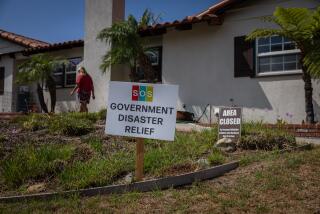Cracking Homes Get Legislatorsâ Attention
The La Palma house that Anne and Steve Polonis have shared with their two daughters for the last three years has slowly become akin to something in a horror movie.
Bedroom doors stick. Windows and sliding doors shatter. Pieces of ceilings break loose. Pits and cracks, some as wide as a manâs hand, riddle the concrete foundation beneath the carpet. Cracks lace the driveway in the front yard and the bottom of the pool in the backyard.
Just one person at a time can use the stairs to the second floor because the weight of more would cause the staircase to collapse. Water pipes are corroded, and the tap water isnât safe to drink, so the family must buy about 10 gallons of water from the grocery each week, Anne Polonis said.
The house shudders âas if it were cold,â and the second-story floors beneath the carpet have become so creaky that people downstairs can hear the familyâs Persian cat walking upstairs, she said.
Legislators on Wednesday lent support to the Polonises and other homeowners in La Palma, Cypress and Lakewood, whose houses have been damaged because of deteriorating foundations and whose insurance companies refuse to pay repair claims.
State Sen. Cecil N. Green (D-Norwalk) had helped organize a walking tour Wednesday of several such homes in Cypress. Polonis, whose home on Amberwood is one of the most damaged, led the tour.
Wednesday night, nearly 300 people whose homes have been damaged attended a public hearing conducted by Green in the Mormon Church Cultural Hall in Cypress. At the hearing, experts told how and why the homesâ cement foundations have corroded.
According to Greg Axten of American Geotechnical of Anaheim, analyses of soil samples taken from about 200 of the damaged homes reveal a high degree of salt in the soil. Some salt has been present in the soil since prehistoric times, he said.
More salt arrived in rain runoff. The salt is soaked up by the homesâ porous cement foundations, he said, and the salt crystallizes, leading to corrosion of the foundation. The homesâ thin foundations compound the problem: In the 1950s and 1960s, when most of the homes were built, the foundations were poured just two inches thick.
Deterioration of the foundation eventually causes a house to shift, fold and, in cases such as that of the Polonis home, slowly lean toward collapse, he said.
Owners Feel Trapped
Homeowners said they cannot repair their homes because their insurers deny the claims. Many feel trapped because they cannot sell their house or afford repairs or rebuilding, which could cost $50,000 to $100,000.
Green, a member of the state Senateâs Insurance, Claims and Corporations Committee, said he is gathering facts to introduce legislation that would help the homeowners.
He said he has visited about 20 damaged homes in his 33rd District and predicted that such deterioration will affect âmany thousands of homesâ in the area in coming years.
âThere have been a lot of studies, but nobodyâs come up with answers yet,â he said. âThe homeowners need answers.â
Although many questions about why the deterioration is occurring were answered at the hearing, other questions lingered, such as how homeowners would pay for reconstruction or be able to sell their homes.
The Polonises, who have spent $5,000 on repairs, are suing their insurance company. The company has denied their claims since July, 1985, when it attributed the deterioration to âfaulty constructionâ and âearth movement.â
They are also suing the real estate agent who sold them the house in December, 1983. The Polonises allege that the agency knew of the problem in the area before the sale but concealed it from them.
More to Read
Sign up for Essential California
The most important California stories and recommendations in your inbox every morning.
You may occasionally receive promotional content from the Los Angeles Times.










